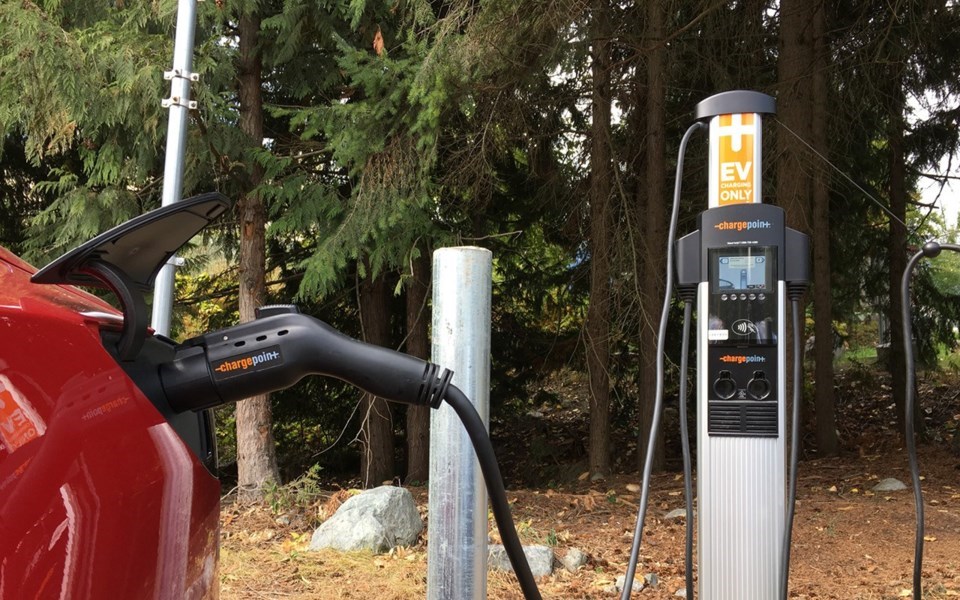Squamish and the Sea to Sky set the standard for zero-emissions vehicle (ZEV) adoption in Canada, according to West Vancouver-Sunshine Coast-Sea to Sky Country MP Patrick Weiler.
“While B.C is leading the country in terms of zero-emissions vehicle adoption rates, the leading metropolitan area is actually Squamish,” said Weiler immediately after the federal government released its Electric Vehicle Availability Standard earlier this month.
“Right now in Canada, transportation is our second-biggest source of greenhouse gas emissions—it’s about a quarter of Canada’s emissions,” he said.
The new standard, announced by Environment Minister Steven Guilbeault on Tuesday, Dec. 19, is designed to phase out the sale of vehicles powered solely by gas or diesel completely by 2035, by ramping up the percentage of ZEVs required to be sold by automakers in Canada over a 12-year period.
The standard, which will be rolled out Canada-wide, starts with a 20-per-cent ZEV sales requirement in 2026, and keeps going up each year until it’s 100 per cent by 2035.
“Given that the average age of a vehicle is 15 years, putting in place a 100-per-cent ZEV sales target by 2035 will help end the use of polluting light-duty vehicles by 2050,” reads the government release on the standard.
The new federal standard is not as aggressive as the B.C. provincial standard (introduced in October), but still reaches the same 100-per-cent ZEV target by 2035. Comparing the two, the B.C. standard sets targets of 26 per cent ZEV sales by 2026 (compared to 20 federally), 90 per cent by 2030 (60 per cent federally), and 100 per cent by 2035.
Governed by the Canadian Environmental Protection Act, automakers will be issued credits for each ZEV they sell, with credits determined by how far a vehicle can travel while only powered by a battery. Automakers can bank credits if they sell more than the required percentage of vehicles, or sell them to other automakers. They can also make up 10 per cent of the credits they need annually by investing in public charging stations. Companies that don’t meet the target will generate a deficit they must discharge within three model years.
Weiler said B.C. is already well ahead of the curve in electric vehicle sales (21 per cent in 2022), and is setting the standard for Canada.
“B.C. leads the way with zero-emissions mandates, and we can see the impact of that. We want a model that is good practice, and to replicate that elsewhere. B.C. has for a long time been an innovator, and this is another good example of that,” he said.
“We’re not quite where Norway is, where over 80 per cent of new vehicles sold last year were zero-emissions vehicles, but we’re certainly leading in North America, and that’s why we’re seeing it’s easier to get an electric vehicle here than it is in other provinces.”
Electric vehicles are known to be more expensive than their internal-combustion counterparts—an issue acknowledged by Canadian governments, which offer incentives to early ZEV buyers to bring the price tags closer to parity. Weiler said in the long-run, ZEVs make more sense for Canadians due to lower fuel and maintenance costs, and even now are dropping in price and becoming more affordable.
Another common issue raised by critics of ZEV adoption is their higher mineral requirements. Weiler said encouraging more sustainable mining practices is an important part of the equation in decarbonizing the global economy, but dismissed a common trope that electric vehicles are somehow more damaging to the environment than their gas-powered counterparts due to the resources needed to create them.
“I categorically dismiss the notion that electric vehicles are somehow less environmentally sustainable than gas-powered cars,” he said.
“The materials that are required to build it in the first place have slightly higher impact, but when we’re talking about Canada, already 85 per cent of our grid is non-emitting, and we’re committed to getting to 100 per cent by 2030. There is little to no environmental impact with the operation of the vehicle over time, whereas when we’re talking about gasoline-powered, that is a quarter of our emissions in Canada, so imagine if we’re able to draw that down to near zero.”
The proliferation of electric vehicles globally is another opportunity for Canada, said Weiler.
“We’ve brought forward our critical minerals strategy, and provinces like British Columbia are large producers of copper, so we need to expand on that and do it in a sustainable way.”
Consumer purchases of ZEVs under the new Zero Emissions Vehicle Standard will be supported by the federal government investing $2 billion in its incentives program, which offers up to $5,000 in incentives to buyers across the country. Coupled with provincial incentives, buyers in B.C. can have as much as $9,000 knocked off the price of a ZEV if they qualify.
There will also be efforts to vastly expand the public charger network in Canada. Currently, there are more than 25,000 across the country, and the government plans to install more than 43,000 more.




